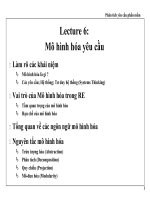NR 326 Lecture 6 Succession
Bạn đang xem bản rút gọn của tài liệu. Xem và tải ngay bản đầy đủ của tài liệu tại đây (2.18 MB, 35 trang )
Succession
The gradual supplanting of one community of plants by another
Accompanied by changes in stand structure and species composition
1
Forest succession process
Evolution
Degradation
Grass
Pioneer tree species
Seral tree species (increasing in tolerance
(very intolerant
as replacement continues)
Climax tree species (very tolerant)
2
Succession
Changing in forest structure
3
Succession
Changing in species composition
4
Succession
Changing in forest ecology
5
Primary Succession
where the conditions are originally unfavorable for plant growth, such as bare rock. Gradual erosion and deposition in the area
allows early (hardy) pioneer species to colonize and survive
6
Secondary Succession
Occurs after existing vegetation is removed such as after a flood, fire or mechanical process (agricultural). The soil is already fertile or/and
the seed was already in the soil, so plants can easily become established.
7
Stand development stages
8
Stand initiation stage
9
Stand initiation stage
Follows major disturbances (wind, fire, clear-cut)
Regeneration of open space from seed, sprouts & advance regeneration
Pioneer species occupy
One cohort or age class
High density
Stage ends when canopy becomes continuous and trees begin to compete with each other for light and
canopy space
10
Stand initiation stage
Management implications
• Site Preparation to favor a certain
• Light Tolerance
• Future species composition
• Regeneration mechanism advantage
• Density
11
Stem exclusion stage
12
Stem exclusion stage
The intolerant trees continue rapid height growth
while the tolerant trees occupy their
respective niche.
Competition is intense and density-dependent self-thinning occurs
Canopy continues to have one cohort. Both intolerant and tolerant trees may share the main canopy
Characterized by growth, competition and mortality produced spatial adjustments
Diameter Distribution change
13
Stem exclusion stage
Management implications
Thinning to shape desired future condition of the stand
Species composition and stand structure/form
Density/spacing arrangements
14
Understory re-initation stage
15
Understory re-initation stage
Big trees with larger crowns , so when one tree dies the surrounding trees can not fill the gap
Seed is produced, seedlings occur in the gap
New cohorts can eventually enter the canopy, diameter distribution becomes bimodal (2 peaks)
The stand reach their economic maturity
16
Understory re-initation stage
Management implications
Progression to this stage of stand development and length of this stage can be adjusted through
silvicultural actions
17
Old-Growth stage
18
Old-Growth stage
Climax species dominate the site and reproduce successfully
Intolerant trees cannot reproduce
High structural diversity
Growth is slow or may be negative
19
Impact of Succession on Forest Management
Accelerating succession by applied intermediate disturbance
20
Impact of Succession on Forest Management
Heavy cuts
Light
Light selection
selection
VS
cuts
cuts
Great disturbance to the
Small disturbance to the
natural
natural
21
Impact of Succession on Forest Management
If you are hoping to regenerate certain species naturally following a harvest, it is important to know what successional stage
these species typically occupy; and, what type of harvest will generate the desired conditions for stand establishment. (Jeff
Martin and Tom Gower, 1996)
22
Impact of Succession on Forest Management
Early stages
Later stages
High percentage of leaf
High percentage of woody tissue
tissue
(branches, twigs and stems)
Decomposed process
Fast
Slow
Nutrient concentration
Great nutrient concentration
Poor nutrient concentration (nutrients
The litter
being locked up)
Water transportation
Easy
Difficult
The growth of forests decreases as they age
23
Impact of Succession on Forest Management
Reduce the rotation length
Long
cutting
cycle
Sort
Sort cutting
cutting
VS
cycle
cycle
24
Impact of Succession on Forest Management
Uneven-aged management (maintain a balance of healthy, vigorous trees and a
smaller number of mature trees)
VS
25









